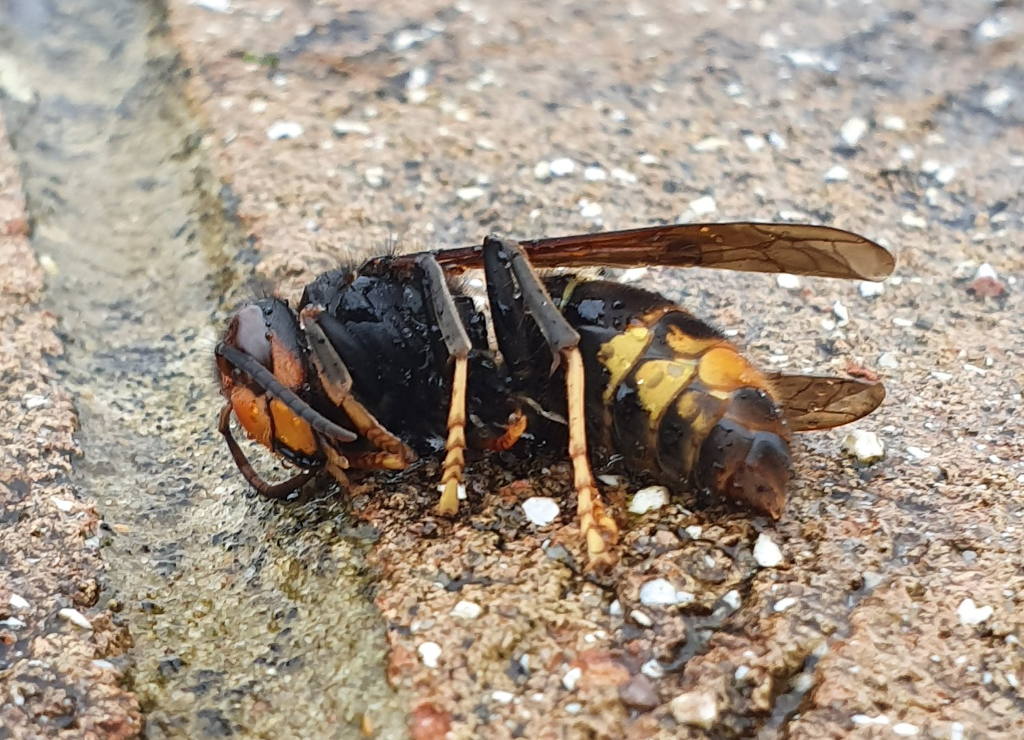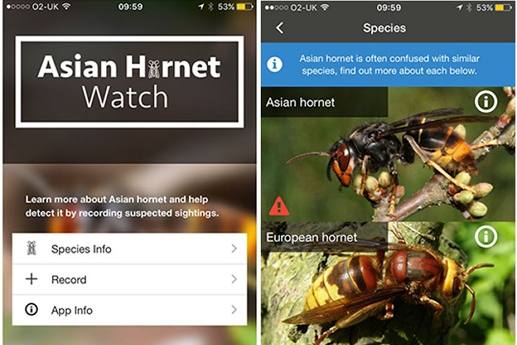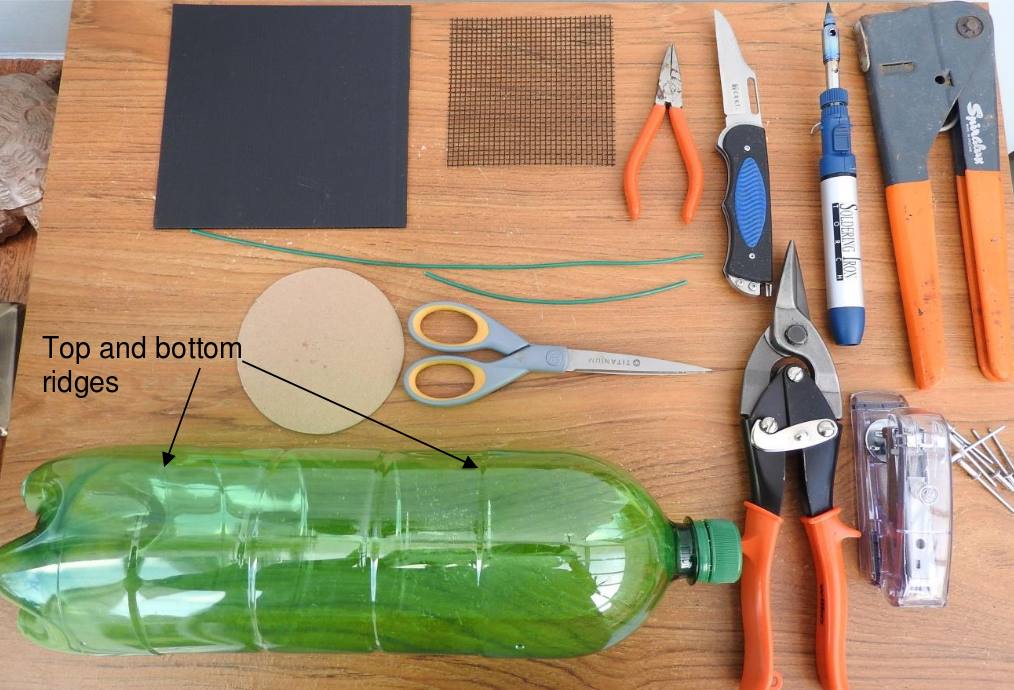With the first Asian hornet (Vespa velutina nigrithorax) of the year being found on Sunday (2 February) by a member of the public in St Brelade, Jersey after being disturbed from hibernation, it's a reminder to us all to start thinking about monitoring for these non-native insects here on mainland UK.

First Asian hornet of the year found in St Breladem, Jersey
Picture: Jersey Asian Hornet Facebook Group
With the English Channel only separating us from the Channel Islands and France, there's no better time than now to start looking.
Act early
The annual lifecycle of the Asian hornet begins in February/March when the queens that were mated in the autumn the previous year come out of hibernation and start to build their nests. At this stage, it's very difficult to tell the difference between a wasp's nest and an Asian hornet's nest as the entrances for both nests are at the bottom and therefore look similar.
To put things into perspective, it is estimated that around 6,000 Asian hornets can emerge from a nest later in the year of which 180-500 could be queens.
Confirmed sightings
The first confirmed sighting in the UK was in 2016 in Tetbury, Gloucestershire with the last confirmed sighting closer to home in 2019 in Christchurch, Dorset.
What can you do?
If you have a mobile phone, the quickest and best way to identify and report a possible sighting is to use the Asian Hornet Watch app which has been designed to record and help the early detection of Asian hornets.
The app provides an identification guide to help check which species you have seen and an opportunity to record your sightings. Download free of charge from Google Play or iTunes.
 Alternatively, report the sighting to the Non-Native Species Directorate but they will need a good photo for identification purposes before taking any further action.
Alternatively, report the sighting to the Non-Native Species Directorate but they will need a good photo for identification purposes before taking any further action.When should you be monitoring?
With the new queens emerging from hibernation mid-February/March, it's important to have monitoring traps in place before the queens can get a chance to establish themselves. Early detection of just one Asian hornet queen in the spring can potentially avoid hundreds of new queens being produced later in the year ready to expand the following year.
The Department for Environment, Food & Rural Affairs (DEFRA) is recommending monitoring traps be placed in all areas of the country, even where there is no Asian hornet incursion known at the time. This is in the expectation that if Asian hornets are in the area then they will be trapped and identified.
The use of bio-traps is essential for the capture of Asian hornets. We must avoid the risk of trapping bees or other insect pollinators - a risk that becomes unavoidable when using chemical baits, which are non-selective and make no distinction between bees and wasps.
How do you monitor?
It's simple and it's even good for the environment as uses recyclable materials.

© National Bee Unit
For full instructions, download the Monitoring Trap for the Asian Hornet published by the National Bee Unit.
It's important that the trap should not drown insects but provide a surface for them to stay afloat of the attractant so those that are not Asian hornets can be safely released.
The following information can be found on the National Bee Unit's website, published as part of the instructions for making your own monitoring trap for the Asian hornet.
This trap is meant for monitoring in areas where the Asian hornet is not yet established.
When to hang out monitoring traps?
Reports from France suggest that in areas where spring trapping has been used, subsequent numbers of Asian hornet nests are reduced by as much as 90%. Monitoring should begin in early spring when queen hornets emerge from hibernation and search for food to begin constructing their primary nest and raise the first cycle of brood.
Adult hornets will be on the wing throughout the beekeeping season, so monitoring should continue right into the autumn.
What bait should you use?
At the end of hibernation, emerging queens have a raised energy requirement and show a preference for sweet foods. In early spring such food resources are comparatively rare in the environment, so this means that sweet baits are highly attractive for the early capture of Asian hornet queens. There are many variations of sugar baits, all of which appear to be reasonably effective. These include mixes of sugar and various types of dark beer, various types of alcohol and even simple sugary baits such as apple juice. French beekeepers have also used a mixture of dark beer, mixed with 25 ml of strawberry dessert sauce and 25 ml of orange liqueur.
Where should you hang traps?
Traps should be hung in sunny areas, avoiding deep shade where Asian hornets are unlikely to forage. Traps can be hung in trees at the height of a person.
A good place to hang traps is somewhere where you can easily watch, such as in your garden. Since Camellias come from the part of the world where the Asian hornet originates, these flowers, especially the single forms, are favourites of founding queens to refuel as they make their flights out of hibernation to find new primary nest sites. They will however feed from any spring flowering shrub that produces a good nectar supply.
How to empty the trap
Release all other live insects. In order to preserve as many non-target species as possible traps should be visited and emptied regularly; ideally daily. It is very important that damage to native European hornets, wasps and any other insects is kept to an absolute minimum.
If your trap is adapted from an off the shelf design and you think you have caught an Asian hornet, then you may find it helpful to place the whole trap, unopened, into a freezer bag that you can seal tightly; place the bag containing the trap into a domestic freezer for 12 hours before opening, to avoid losing your suspect specimen.
Need any advice?
If you would like to find out more about the Asian hornet, there's is information on the following websites:
Asian Hornet Action Team (AHAT)
British Beekeepers' Association (BBKA)
National Bee Unit (NBU)
Non-Native Species Secretariat (NNSS)
There is also an online course on the AHAT website to test your knowledge on the Asian hornet.
